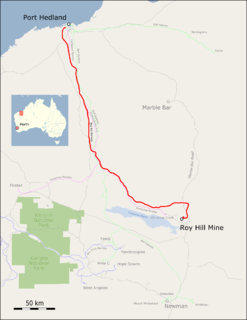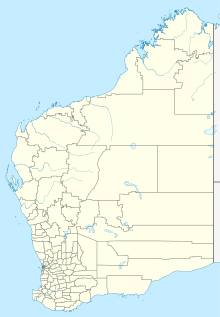The Pilbara is a large, dry, thinly populated region in the north of Western Australia. It is known for its Aboriginal peoples; its ancient landscapes; the red earth; and its vast mineral deposits, in particular iron ore. It is also a global biodiversity hotspot for subterranean fauna.

Fortescue Metals Group is an Australian iron ore company. As of 2017, Fortescue is the fourth-largest iron ore producer in the world. The company has holdings of more than 87,000 km2 in the Pilbara region of Western Australia, making it the largest tenement holder in the state, larger than both BHP and Rio Tinto.

The Hamersley & Robe River railway, majority-owned by Rio Tinto, and operated by its subsidiary Pilbara Iron, is a private rail network in the Pilbara region of Western Australia for the purpose of carrying iron ore. The network is larger than any other Australian heavy freight rail network in private ownership. The total length of its track is about 1,700 km (1,056.33 mi).

The Goldsworthy railway, owned and operated by BHP, is a private rail network in the Pilbara region of Western Australia built to carry iron ore. It is one of two railway lines BHP operates in the Pilbara, the other being the Mount Newman railway.

The Fortescue Railway, owned and operated by Fortescue Metals Group (FMG), is a private rail network in the Pilbara region of Western Australia built to carry iron ore. It opened in 2008. When it was completed it was the heaviest haul railway in the world, designed for 40 tonnes axleloads, 2.5 to 5 tonnes heavier than the other Pilbara iron ore rail systems. On 4 November 2014, FMG Rail commenced trialling 42 tonnes axle loads.

The Cloudbreak mine is an iron ore mine located in the Pilbara region of Western Australia, 89 kilometres west-south-west of Nullagine, in the Chichester Range.
The Christmas Creek mine is an iron ore mine located in the Pilbara region of Western Australia, 61 kilometres south-south-west of Nullagine, in the Chichester Range.

Iron ore mining in Western Australia, in the 2018–19 financial year, accounted for 54 percent of the total value of the state's resource production, with a value of A$78.2 billion. The overall value of the minerals and petroleum industry in Western Australia was A$145 billion in 2018-19, a 26 percent increase on the previous financial year.
The Area C mine is an iron ore mine located in the Pilbara region of Western Australia, 92 kilometres west-north-west of Newman.
The Jimblebar mine is an iron ore mine located in the Pilbara region of Western Australia, 41 kilometres east of Newman.
The Pardoo mine was an iron ore mine located in the Pilbara region of Western Australia, 75 kilometres east of Port Hedland.
The Yarrie mine is an iron ore mine located in the Pilbara region of Western Australia, 90 kilometres north-east of Marble Bar.
The Orebodies 18, 23 and 25 mine, part of BHP's Eastern Ridge hub and officially referred to as the Newman East operation, is an iron ore mine located in the Pilbara region of Western Australia, 8 kilometres east of Newman. The mine is majority-owned and operated by BHP, and is one of seven iron ore mines the company operates in the Pilbara. The company also operates two port facilities at Port Hedland, Nelson Point and Finucane Island, and over 1,000 kilometres of rail in the Pilbara.
The Roy Hill mine is an iron ore mining project in the Chichester Range in the Pilbara region of Western Australia, located 115 kilometres (71 mi) north of Newman and 277 kilometres (172 mi) south of Port Hedland. With indicated and inferred reserves of more than 2.4 billion tonnes, it is expected to become one of the largest mining projects in Australia. Mining operations will produce 55 million tonnes of iron ore per annum with an operating life of more than 20 years.
The Yindjibarndi are an Aboriginal Australian people of the Pilbara region of Western Australia. They form the majority of Aboriginal people around Roebourne. Their traditional lands lie around the Fortescue River.
The South Flank mine is an iron ore mine located in the Pilbara region of Western Australia, 156 kilometres northwest of Newman. and approximately 9 km to the south of BHPs Mining Area C operation. Construction at South Flank began in July 2018, the Mine is already producing ore and is partially complete, once opened it will become the largest processing facility in Western Australia.
The Mt Webber mine is an iron ore mine operated by Atlas Iron and located in the Pilbara region of Western Australia, 230 kilometres (140 mi) from Port Hedland, to where the ore is transported. Mt Webber, opened in 2014, is the company's primary operation.
The Eliwana mine is an iron ore mine operated by the Fortescue Metals Group (FMG) and located in the Pilbara region of Western Australia, 90 kilometres west of Tom Price. The mine forms the core of the company's Western Hub, one of three of its active mining areas, together with the Chichester Hub and the Solomon Hub.
The Firetail mine is an iron ore mine operated by the Fortescue Metals Group (FMG) and located in the Pilbara region of Western Australia, 60 kilometres north of Tom Price. The mine is part of the company's Solomon Hub, one of three of its active mining areas, together with the Chichester Hub and the Western Hub.

The Roy Hill railway, officially the Roy Hill Infrastructure railway, owned and operated by Hancock Prospecting, is a private rail network in the Pilbara region of Western Australia built to carry iron ore.










